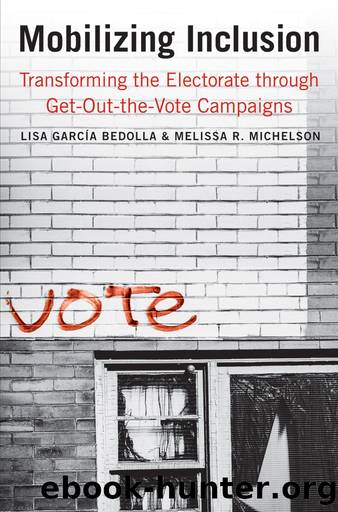Mobilizing Inclusion by Lisa García Bedolla

Author:Lisa García Bedolla
Language: eng
Format: epub
Publisher: Yale University Press
Published: 2012-01-15T00:00:00+00:00
5
NOTES FROM THE FIELD: RUNNING AN EFFECTIVE MOBILIZATION CAMPAIGN
Lucas and Jackson, aged fourteen and seventeen, felt out of place in this neighborhood. Even though it was located only a few blocks from their school, it was over a mile from where they lived, and the area felt completely unfamiliar. The lawns were fenced and gated, with large, fierce-looking dogs patrolling the small patch of land in front of each house. Recruited by their local church, the boys had volunteered to help motivate individuals to vote. For every hour they worked, a club at their high school would receive a donation. Yet, when they found themselves in the field, they began to feel nervous about what was expected of them. They had received little training from church organizers about how to talk to voters and had little political experience themselves. They found it daunting to imagine knocking on strangersâ doors to talk to them about voting. To make matters worse, one of the first houses they visited was home to two unfriendly pit bulls that took issue with being woken from their nap by strangers wanting to visit their ownerâs house. Being chased by the dogs made them even more wary about the work they had agreed to do. The resident voter, needless to say, did not receive a door-to-door canvassing visit that day.
Unleashed aggressive dogs, wild geese, and hostile targeted voters were just a few of the unexpected challenges that CVI canvassers faced as they worked to mobilize low-propensity voters across the state of California. These are some of the many contextual factors that affect campaigns but rarely get mentioned in the voter mobilization literature. Yet they do have an impact on canvasser morale and therefore on overall campaign effectiveness. After our evaluations of the CVI campaigns during the 2006 elections, we found that there was a great deal of variability in how effective these efforts were. Campaigns that looked very similar on paperâimplemented by established organizations with similar levels of capacity, motivated volunteers, and experience in voter mobilizationânevertheless had strikingly different results. The anecdotal information from the field during the 2006 elections suggested to us that organizational and contextual factors might help to explain that variability.
When we looked to the literature to provide us with guidance about what factors might be at play, we found that published experimental work on face-to-face canvassing almost always showed the campaigns to be effective. The studies described door-to-door canvassing as effective in mobilizing a variety of populations, including youth, Latinos, and African Americans (Green and Gerber 2008; Michelson 2003, 2005, 2006; Green and Michelson 2009). Published reports seemed to suggest that door-to-door canvassing always worked, regardless of the quality of the campaign. Yet Donald Green and Alan Gerberâs (2008) brief summary of the dozens of door-to-door campaigns that have been conducted since their path-breaking work in 1998 (Gerber and Green 2000b) includes references to several (largely unpublished) campaigns that failed to move voters to the polls. The problem, then, is that almost all
Download
This site does not store any files on its server. We only index and link to content provided by other sites. Please contact the content providers to delete copyright contents if any and email us, we'll remove relevant links or contents immediately.
The Secret History by Donna Tartt(18743)
The Social Justice Warrior Handbook by Lisa De Pasquale(12080)
Thirteen Reasons Why by Jay Asher(8736)
This Is How You Lose Her by Junot Diaz(6700)
Weapons of Math Destruction by Cathy O'Neil(6084)
Zero to One by Peter Thiel(5637)
Beartown by Fredrik Backman(5545)
The Myth of the Strong Leader by Archie Brown(5374)
The Fire Next Time by James Baldwin(5199)
How Democracies Die by Steven Levitsky & Daniel Ziblatt(5096)
Promise Me, Dad by Joe Biden(5036)
Stone's Rules by Roger Stone(4989)
100 Deadly Skills by Clint Emerson(4798)
A Higher Loyalty: Truth, Lies, and Leadership by James Comey(4796)
Rise and Kill First by Ronen Bergman(4658)
Secrecy World by Jake Bernstein(4593)
The David Icke Guide to the Global Conspiracy (and how to end it) by David Icke(4557)
The Farm by Tom Rob Smith(4404)
The Doomsday Machine by Daniel Ellsberg(4375)
